Abstract
This paper presents a design method for a high-power optical system with multiple channels to achieve high-quality color-mixing and uniform lighting. The high-power optical system consists of a multi-channel reflector and a color-mixing component. The optical systems with different parameters are simulated to analyze the color-mixing performance. Simulation results show that the illumination uniformity of all optical systems is greater than 0.77, and the maximum color difference is 0.014. This optical system can be introduced into applications, such as illumination of machine vision, simulating daylight, smart lighting, and so on.
1. Introduction
In recent years, LED (light-emitting diode) technology has grown rapidly and is used in a variety of applications. White LED technology has been a hot research topic in the field of lighting. Compared with white LED technology using phosphors, RGB (red green and blue) LED mixing technology is flexible and has a richer spectrum. Many researchers have done a lot of work in the field of RGB LED color-mixing. Dejan Grabovičkić et al. design a metal-less collimator using the simultaneous multiple-surface method. The back of this collimator is designed as a grooved surface providing two TIR (total internal reflection) reflections for all incident light and achieving good color mixing [1]. Simone Sorgato et al. propose a freeform shell-mixer according to the edge ray and the conservation of étendue principles. This freeform mixer has good color-mixing ability as well as a smaller size compared to the spherical mixer. [2]. However, most of the researchers’ design approaches only improve the color mixing of a single group of RGB LEDs. In most cases, multiple RGB LED groups need to be integrated to meet national industry standards. Therefore, it is important to achieve high-power uniform color mixing by improving the quality of the color mixing light produced by multiple RGB LED groups.
Several papers have shown that the uniformity of color and illumination can be improved by changing the arrangement distribution of multiple RGB LED groups [3,4,5]. Zezhou Zheng et al. used this method of calculating LED distribution for plant lighting, and the result showed a color-mixing uniformity of 84.54% [6]. However, this method of calculating the optimal distribution requires complex calculations and cannot flexibly adjust the output power and color. It is difficult to achieve high-power in the illuminated area only by using mutual compensation of the light intensity distribution between multiple LEDs. Therefore, it is necessary to optically design the individual LED in the arrays or the entire array by some optical components. Liu Peng et al. design free-form lenses for a single light source to produce rectangular irradiance distribution for color mixing [7]. The large-scale color uniform illumination is obtained by arranging the distribution of the lens array. Thøger Kari et al. optimize a non-rotationally symmetric lens for each light source, to solve the poor uniform color arising when multiple rectangular images formed from LED dies are combined into a circular spot profile [8]. Allen Jong-Woei Whang et al. propose a theory about the LED array arrangement and design method of the LED lens [9]. By this method, a flat illumination distribution can be obtained, and the luminescence angle of the array can be designed at will. Satisfactory uniformity is easily achieved by designing lenses for each group of RGB LEDs individually and then combining them into lens arrays. However, this approach makes design complex and creates a large volume for optical systems.
Considering multiple RGB LED groups as a whole during optical design can effectively reduce the size of the optical system. Zhen-min Zhu et al. propose an indirect lighting method for uniform illumination [10]. They put the diffuse reflective surface directly over the ring LED array. The simulation results show that uniformity is good when the illuminating distance is close to the panel size. Feng Zhao et al. analyze the color mixing of two types of light guides that have square and round cross-sections [11]. The results show that both types of light guides show similar color-mixing performance. There is no significant improvement in illumination and color uniformity. Edward Bailey proposed a multi-lobe non-rotationally symmetric lens that uses six colored LEDs (two groups of RGB LEDs) as the light source to produce a high-intensity narrow beam with uniform color [12]. These methods sacrifice some uniformity to obtain systems with relatively simple structures. When an entire LED array is optically designed, it is inevitable that an imprecise approach to light control is taken, which cause a decrease in the uniformity of the color in the mixed area. Novel optics should be adopted to improve this problem. Wei Yuan et al. propose an integrated double-sided random microlens array fabricated by double-sided exposure technique for laser beam homogenization. The random speckle field is achieved by the superposition of the divided random beams [13]. They also propose an iterative segmentation method to design the structure of random microlens array with controllable divergence angle and high filling factor [14]. Optical characteristics of random microlens arrays provide inspiration for high-power color-mixing optical systems. By adding random microlens arrays to the optical system, the uneven color-mixing problem of RGB LED arrays can be solved.
At present, the problem of high-power color mixing based on multiple RGB LED groups is that the number of light sources makes the design theory based on individual light sources inapplicable. This paper presents a design method for a high-power color-mixing optical system based on multiple RGB LED groups. This system consists of three components: a multi-channel reflector, a TIR lens, and a double-layer microlens array. The multi-channel reflector is designed to converge the light energy of multiple light sources and to achieve high power output. The converged light can be precisely controlled by the TIR lens and double-layer microlens array to improve the color and illumination uniformity in the illuminated area.
2. Design Methods
Precise control of the rays from the LED array is necessary to achieve high output power and uniform color-mixing. The design method proposed in this paper consists of two parts: a multi-channel reflector and a color-mixing component. The multi-channel reflector is used to reach high output power, and the color-mixing component provides precise control of the rays to achieve uniform color mixing. Figure 1 schematically represents the structure of the multi-channel optical system.
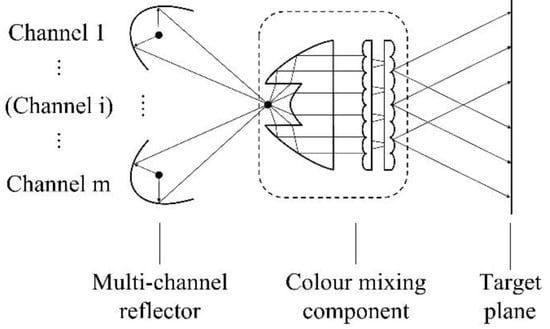
Figure 1.
Schematic representation of multi-channel color-mixing optical system.
The beams from RGB LEDs arrays are first focused to a point by the multi-channel reflector. Then the converged beams are mixed and redistributed by the color-mixing component to create a uniform geometric pattern on the target plane.
2.1. Principle of the Multi-Channel Reflector
The multi-channel reflector is composed of multiple elliptical reflector surfaces. In an elliptical reflector, the rays from the focal point are focused on the other focal point due to equal path lengths. Therefore, as shown in Figure 2, beams from multiple channels are converged to the common focus to create a virtual LED with the spectrum and energy of all LEDs.
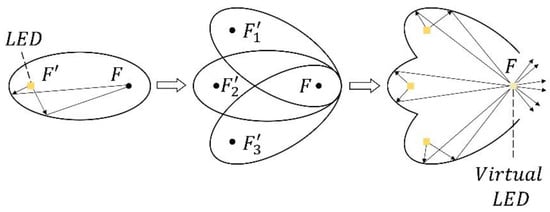
Figure 2.
Schematic representation of multi-channel reflector.
The example shown in Figure 2 is a three-channel reflector. The light sources are mounted on the focal point (,, and ), and the rays are focused to the common focus (F). Therefore, a virtual light source is formed at the position of common focus (F). As shown in Figure 3, the light intensity distribution and the beam angle will change after the light is reflected by the elliptical reflector due to the aperture limitation.
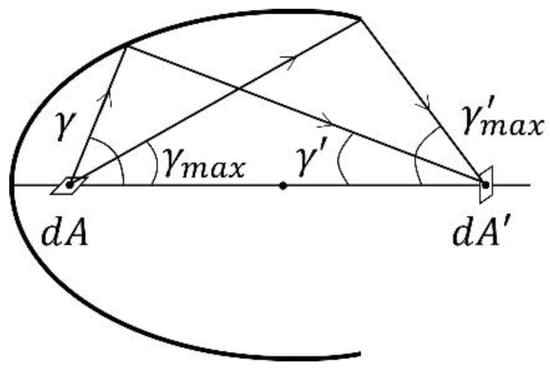
Figure 3.
Principle of the elliptical reflector.
The intensity distribution of the virtual light source produced by a channel can be written as
where is the luminance of light source. is emitted angle of rays at common focus (F). and are minimum and maximum values of , respectively. is an area element at focal point [15]. The number of channels will change the light intensity distribution of the virtual light source. The intensity distribution of the virtual light source produced by multiple-channel can be expressed as
where is the light intensity distribution in the spherical coordinate system, and is the number of channels. The increase in the number of channels allows the installation of more LEDs to enhance the power. At the same time, this leads to an increase in the beam angle of the virtual light source, which affects the mixing of light.
2.2. Principle of Color-Mixing Components
The color-mixing component is a key part of the high-power optical system for uniform color mixing. It is composed of a TIR lens and double-layer microlens arrays (a microlens array and a random microlens). The TIR lens is designed based on the virtual light sources produced by the multi-channel reflector, and it is used to collimate the rays from the multi-channel reflector. The microlens array can uniformly reshape collimated beams, and random microlens can achieve color mixing sufficiently. The design principle of the double-layer microlens array is shown in Figure 4.
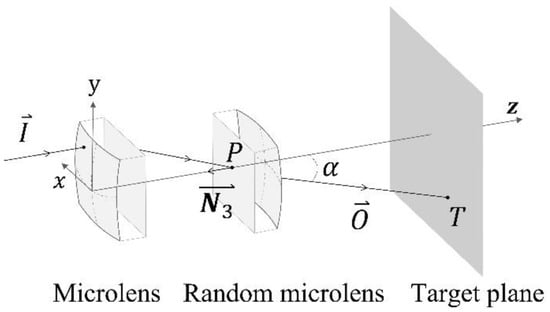
Figure 4.
The design schematic diagram of the double-layer microlens array.
A random microlens array is placed on the focal plane of the microlens array. The collimated beam is focused at point P on the surface of the random microlens array and is finally refracted to point T on the target plane. The rays are refracted four times in the double-layer microlens array. In the i-th refraction, the relationship between the incident ray and the emergent ray can be expressed as
where represents the unit vector of the incident ray, and is the unit vector parallel to the z-axis. represents the unit vector of the emergent ray, and is a unit normal vector of the refracting surface. When the rays enter the lens from the air is the refractive index of the lens, and when the light enters the air from the lens is the reciprocal of the refractive index of the lens. This light transmission process can be simplified by regarding the double-layer microlens array as a whole. The unit vector of the incident ray is modulated by the double-layer microlens array into the unit vector of the emergent ray. The divergence angle between the unit vector of the emergent ray and the Z-axis can be expressed as
where is the unit vector parallel to the z-axis. The optical system makes use of the random microlens array to produce beams with different angles to achieve uniform mixed color light. The principle of uniform mixing of light in the target plane is shown in Figure 5.
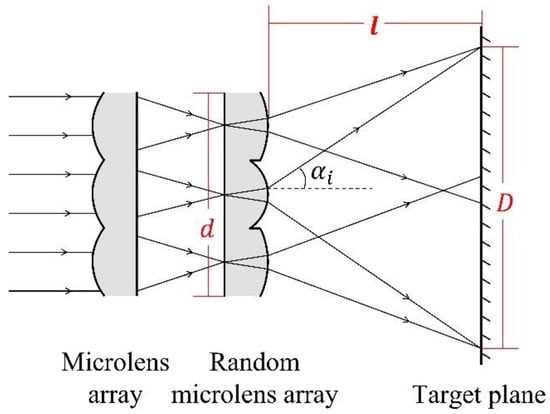
Figure 5.
The schematic diagram of light uniform mixing.
The collimated beam from the TIR lens is split into many parts by the microlens array, and each part is modulated by the random microlens array into beams with different divergence angles . Rays with divergence angles are sufficiently mixed in space, and different areas of colored illumination are formed in the target plane. These colored illumination areas are completely overlapped on the target plane by limiting the range of angles . The range of angle variation is limited by Equation (6)
where D is the length of the illumination area, is the distance from the random microlens array to the target surface, and is the diameter of the circular boundary of the microlens array. In a random microlens array, the average radius of all microlens is used to describe the illumination range on the target plane, and the radius of the random microlens array is used as a random variation parameter to control the angle . The range of variation in radius can be solved by Equation (7).
where is the side length of the microlens, h is the thickness of the microlens, is the radius of the first layer of the microlens array, and is the refractive index of the microlens. is an important parameter that affects the color-mixing uniformity of random microlens arrays. The appropriate radius random variation range can form a high color uniformity and high illumination uniformity lighting [16].
3. Design Examples
Based on the above theory, the optical system can adjust the number of channels to meet different power requirements, control the geometry of the microlens to shape the illumination area, and change the parameters of the reflector to improve the color-mixing effect. Design examples with different parameters are provided to verify the performance of the multichannel optical system. The main parameters of the optical systems are shown in Table 1.

Table 1.
The main parameters of the optical systems.
The parameters of the random microlens array in the system are the most appropriate ones from the previous study [16]. The light sources of the optical systems are OSRAM RGBW LEDs (LE RTDUW S2WN). The light source is located at the focal point of each channel. The number of LEDs installed can be increased by increasing the number of channels. The optical model with three channels and the position of the light source in the system is shown in Figure 6.
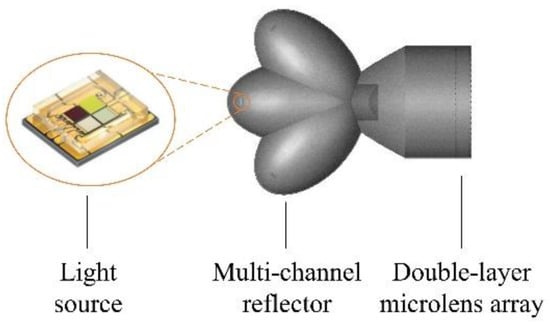
Figure 6.
Optical system model.
The wavelength of red light of the light source is 633 nm, green light is 521 nm, and blue light is 445 nm. The intensity distribution of the light source is Lambert type, and its size is 4 mm × 5 mm. The divergence angle of each LED in the light source is 120 degrees. The mixing effect on the target surface at a distance of one meter is shown in Figure 7.
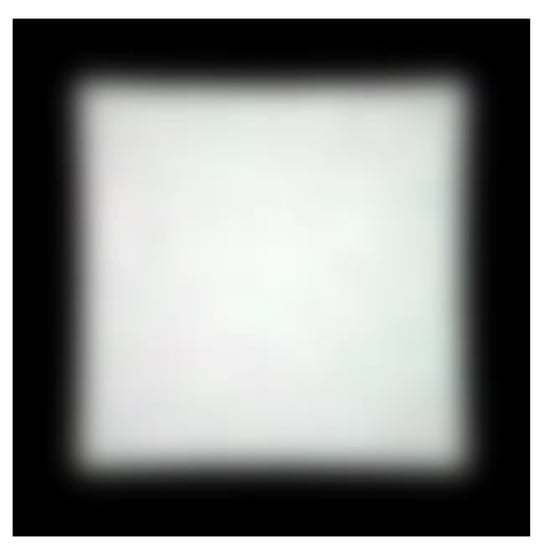
Figure 7.
The pattern of color mixing on the target plane.
As shown in Figure 7, the designed optical system produces rectangular light spots with uniform color and illumination on the target surface.
4. Analysis of Results and Discussion
The optical performance of the optical system is influenced by the reflector and microlens array. The optical systems shown in Table 1 are simulated and analyzed to verify the optical performance. Thirty-six sampling points in the mixing area are selected to describe the uniformity of color mixing, and Figure 8 shows the distribution of sampling points.
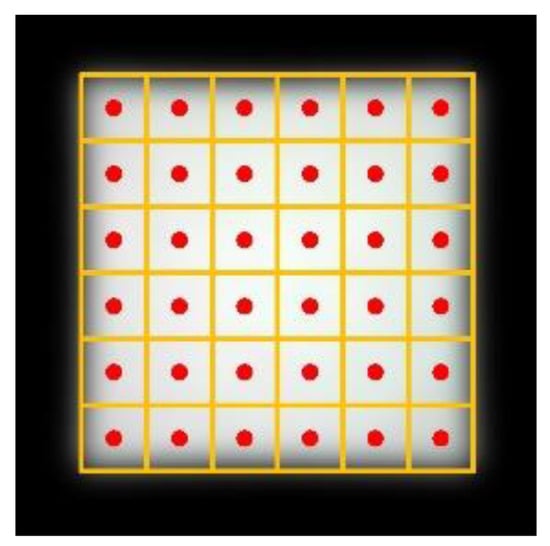
Figure 8.
Distribution of sampling points.
In order to clearly represent the effect of changing parameters on the color difference in the mixing area, the color coordinates of all sampling points are plotted in Figure 9.
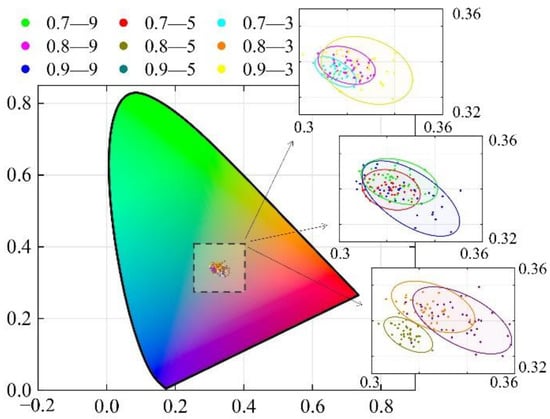
Figure 9.
Color coordinates distribution diagram.
In Figure 9 the legend means ‘eccentricity-number of channels’ (e.g., 0.7—9 represent a model with the eccentricity of 0.7 and 9 channels). The color coordinates of all optical systems are distributed around (0.33, 0.33). This means that all optical systems produce uniform white light illumination. The colored ellipses in Figure 9 represent the confidence ellipse that symbolizes the color-mixing performance of the optical system. The larger the area of the ellipse means the worse the color consistency in the illuminated area. The difference between du’ and dv’ in color coordinates can indicate the color change inside the mixing area.
The trend of the data in Table 2 shows that eccentricity is the main factor that affects the color change. Therefore, a smaller eccentricity is appropriate for this design approach. The color uniformity of the rectangular illuminated area can be represented by the color difference formula defined by CIE 1976. The color difference formula can be written as:
where i is the number of sampling points. and are the color coordinates in the CIE 1976 uniform color system. and are the average of the coordinates of all sampling points [17]. Based on above color coordinates, the color difference of the optical systems are calculated and plotted in Figure 10.

Table 2.
The difference of color coordinates.
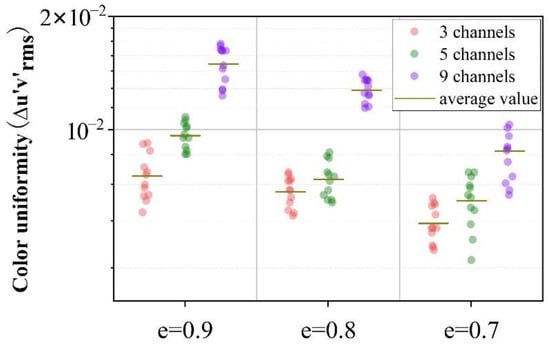
Figure 10.
The color difference of the illuminated area produced by the optical systems.
Figure 10 shows that an increase in the number of channels leads to a slight decrease in color uniformity, but this decrease is acceptable. For example, when the eccentricity is 0.7, the color difference of nine-channel optical systems only increases from 0.006 to 0.009 compared to three-channel optical systems, and more channels mean higher output power. Thus, the nine-channel optical system can produce high-power uniform color-mixing areas.
Changes in optical system parameters also affect the distribution of illumination on the target surface. Normalized illuminance distribution (the ratio of illuminance E to maximum illuminance Emax in the illuminated area) is used to better analyze the variable trends of illuminance on the target surface. The normalized illuminance distribution of the nine optical systems is shown in Figure 11.
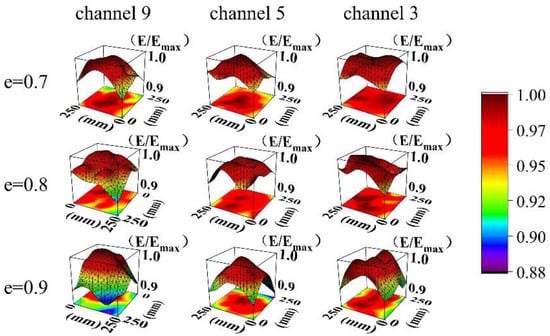
Figure 11.
Normalized illuminance distribution of the illuminated area produced by the optical system.
In Figure 11, the different colors at the bottom represent different illumination levels on the target plane. When the eccentricity of the multi-channel reflector is 0.9, the illumination level at the edge of the illuminated area has a slight decrease. The increase in eccentricity leads to a decrease in the beam angle of the virtual light source so that the energy of the edge rays decreases slightly. Therefore, a small eccentricity is beneficial to improve the illumination uniformity of the light spot. Illuminance uniformity is calculated to further analyze the lighting performance of the optical systems. The illumination uniformity can be expressed as
where U represents the illumination uniformity (U ≤ 1), is the minimum value of illuminance, and is the average value of illuminance. The illumination uniformity U of the illuminated areas is plotted in Figure 12.
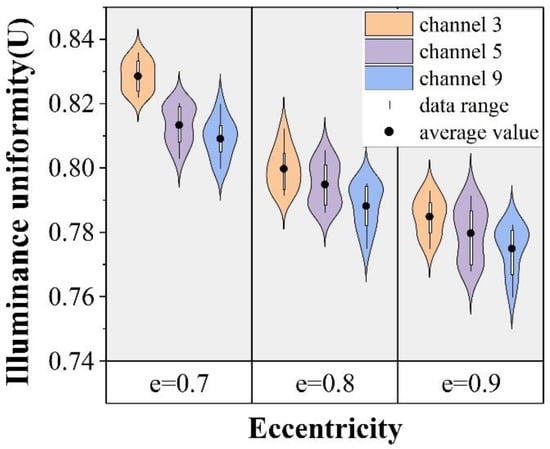
Figure 12.
Illuminance uniformity of the illuminated area produced by the optical systems.
Figure 12 shows the tendency of illumination uniformity for different optical systems. It can be seen that an increase in number of channels leads to a decrease in illumination uniformity. For example, when the eccentricity is 0.7, the illumination uniformity of the optical system with 9 channels is 0.79. However, the illumination uniformity is acceptable, and a larger number of channels can greatly increase the output power of the optical system.
Based on the above analysis, the proposed multi-channel color-mixing optical system based on multiple RGB LED groups is able to produce high quality mixed white light. The advantages of our system are convenient operation, flexible structure, and adjustable output power, compared to other research on improving color uniformity for multiple RGB LED groups. For example, calculating the arrangement and distribution of each color LED can achieve high uniformity [4]. However, the method requires complex calculations, cannot adjust the position and color of the LED, and needs a large volume in order to obtain a high output power. The output power of the multi-channel optical system can be adjusted by changing the number of channels, and the system is capable of installing a maximum of 9 channels and 36 LEDs. The increase in the number of channels changes the light intensity distribution of the virtual light source, which slightly reduces the uniformity of the color mixing. However, the slight decrease in uniformity in exchange for a large increase in power is acceptable.
5. Conclusions
The multi-channel optical system proposed in this paper can uniformly mix colored light to produce high-power white illumination. The multi-channel elliptical reflector enables convergence light energy from multiple RGB LED arrays to produce a high-power output beam. Double-layer microlens arrays shape the collimated beam into illumination areas and improve the uniformity of both color and illumination. The multi-channel high-power optical system can be introduced into many applications, such as illumination of machine vision, simulating daylight, smart lighting, and so on.
Funding
This research received no external funding.
Institutional Review Board Statement
Not applicable.
Informed Consent Statement
Not applicable.
Data Availability Statement
Not applicable.
Conflicts of Interest
The funders had no role in the design of the study; in the collection, analyses, or interpretation of data; in the writing of the manuscript; or in the decision to publish the results.
References
- Grabovičkić, D.; Miñano, J.C.; Benítez, P.; López, J.; Vilaplana, J.; Biot, G.; Buljan, M. Metal-less V-groove RXI collimator. In Proceedings of the Illumination Optics II, SPIE, Marseille, France, 21 September 2011. [Google Scholar] [CrossRef]
- Sorgato, S.; Mohedano, R.; Chaves, J.; Cvetkovic, A.; Hernández, M.; Benitez, P.; Duerr, F. Efficient color mixing through étendue conservation using freeform optics. In Proceedings of the Nonimaging Optics: Efficient Design for Illumination and Solar Concentration XII, SPIE, San Diego, CA, USA, 25 August 2015. [Google Scholar] [CrossRef]
- Yan, T.; Jin, S.; Wang, Y.; Dou, L. Color uniformity and data simulation in high-power RGB LED modules using different LED-chips arrays. In Proceedings of the Light-Emitting Diode Materials and Devices II, SPIE, Beijing, China, 26 November 2007. [Google Scholar] [CrossRef]
- Moreno, I.; Molinar, L.M. Color uniformity of the light distribution from several cluster configurations of multicolor LEDs. In Proceedings of the Fifth International Conference on Solid State Lighting, SPIE, San Diego, CA, USA, 14 September 2005. [Google Scholar] [CrossRef]
- Moreno, I.; Contreras, U. Color distribution from multicolor LED arrays. Opt. Express. 2007, 15, 3607–3618. [Google Scholar] [CrossRef] [PubMed]
- Zheng, Z.; Ma, Z.; Li, R.; Wei, H.; Chu, X.; Liu, H. Design method for improving illumination distribution uniformity of LED plant growth light source. In Proceedings of the 2021 18th China International Forum on Solid State Lighting & 2021 7th International Forum on Wide Bandgap Semiconductors (SSLChina: IFWS), Shenzhen, China, 6–8 December 2021. [Google Scholar] [CrossRef]
- Liu, P.; Wang, H.H.; Wu, R.M.; Yang, Y.; Zhang, Y.Q.; Zheng, Z.R.; Li, H.F.; Liu, X. Uniform illumination design by configuration of LEDs and optimization of LED lens for large-scale color-mixing applications. Appl. Opt. 2013, 52, 3998–4005. [Google Scholar] [CrossRef] [PubMed]
- Whang, A.J.W.; Chen, Y.Y.; Teng, Y.T. Designing Uniform Illumination Systems by Surface-Tailored Lens and Configurations of LED Arrays. J. Disp. Technol. 2009, 5, 94–103. [Google Scholar] [CrossRef]
- Kari, T.; Gadegaard, J.; Jørgensen, D.T.; Søndergaard, T. Compact lens with circular spot profile for square die LEDs in multi-LED projectors. Appl. Opt. 2011, 50, 4860–4867. [Google Scholar] [CrossRef] [PubMed]
- Zhu, Z.; Qu, X.; Jia, G.; Ouyang, J. Uniform Illumination Design by Configuration of LED Array and Diffuse Reflection Surface for Color Vision Application. J. Disp. Technol. 2011, 7, 84–89. [Google Scholar] [CrossRef]
- Zhao, F.; Nadarajah, N.; John, F.V.D. Optical elements for mixing colored LEDs to create white light. In Proceedings of the Solid State Lighting II, SPIE, Seattle, WA, USA, 26 November 2002. [Google Scholar] [CrossRef]
- Bailey, E. Narrow beam RGB array optic. In Proceedings of the Seventh International Conference on Solid State Lighting, SPIE, San Diego, CA, USA, 14 September 2007. [Google Scholar] [CrossRef]
- Yuan, W.; Xu, C.; Xue, L.; Pang, H.; Cao, A.; Fu, Y.; Deng, Q. Integrated double-sided random microlens array used for laser beam homogenization. Micromachines. 2021, 12, 673. [Google Scholar] [CrossRef] [PubMed]
- Yuan, W.; Xue, L.; Cao, A.; Pang, H.; Deng, Q. Close packed random rectangular microlens array used for laser beam homogenization. Opt. Express. 2021, 29, 40878–40890. [Google Scholar] [CrossRef]
- Rehn, H. Optical properties of elliptical reflectors. Opt. Eng. 2004, 43, 1480–1488. [Google Scholar] [CrossRef]
- Chen, Y.A.; Zhang, Y.C.; Fan, M.J.; Pan, D.; Yan, S.H. Design of RGB LED colour-mixing optical system based on double-layer random microlens array. J. Mod. Optic. 2022, 9, 684–692. [Google Scholar] [CrossRef]
- Sun, C.C.; Moreno, I.; Lo, Y.C.; Chiu, B.C.; Chien, W.T. Collimating lamp with well color mixing of red/green/blue LEDs. Opt. Express. 2012, 20, 75–84. [Google Scholar] [CrossRef] [PubMed]
Publisher’s Note: MDPI stays neutral with regard to jurisdictional claims in published maps and institutional affiliations. |
© 2022 by the authors. Licensee MDPI, Basel, Switzerland. This article is an open access article distributed under the terms and conditions of the Creative Commons Attribution (CC BY) license (https://creativecommons.org/licenses/by/4.0/).